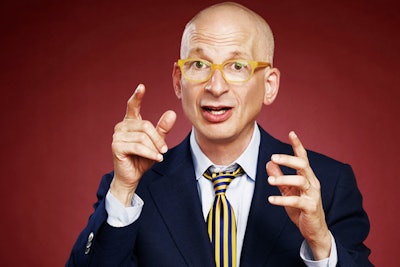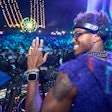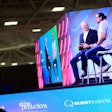
For more than 20 years, Seth Godin has immersed himself in the world of marketing. He is the author of 17 books that have been translated into more than 30 languages. He recently passed the 5,000-post mark on his blog, sethgodin.com, where he posts at least once a day, sometimes a few sentences or sometimes several paragraphs. Godin is also a popular speaker, giving more than three dozen presentations each year, as well as an entrepreneur. His most recent creation is Squidoo, a recommendation Web site that raises money for charity and pays royalties to its million-plus members. In a recent conversation, Godin shared his thoughts on what makes an event worthwhile and why planners should embrace uncertainty.
What has changed and what has stayed the same about marketing strategy over the past few decades?
There’s one master change that I’ve been chronicling for a really long time. Marketing and advertising used to be exactly the same thing in 1965. Advertising was a magical message for turning money into attention, and then you could turn that attention into trust, and you could turn that trust into profit. Most of the culture of marketing is still built around the idea of interrupting strangers and getting them to do what you want. In the last 20 years since I wrote Permission Marketing, that has been turned on its ear, and in fact marketing is now about storytelling. It’s about ideas that spread. It’s about being remarkable. And it’s about talking to people that want to be talked to instead of yelling at strangers.
What is the most effective way to do that?
From the point of view of people in the event industry, no one accidentally goes to a conference. No one accidentally finds themselves at a convention. The people who are there are choosing to be there; they are choosing to pay attention. And yet the people that organize these events squander that attention every day. They squander it with the way they organize the trade show portion of their events. They squander it by having their vendors and sponsors compete to yell at people for their attention. Instead of engaging with people throughout the year, they tend to act like people are going to change the channel at any moment. So they up the noise level and they up the competition for attention, instead of carefully treasuring it and treating it like the asset it is. You have to treat everyone you are interacting with as a treasured guest, as somebody who has many choices and in this moment has chosen to trust you with their attention. Do not squander that attention to make some short-term numbers go up and please your boss, but treat that attention like the privilege that it is.
In a blog post, you wrote, “Organizations that do nothing but measure the numbers rarely create breakthroughs. Merely better numbers.” In the event world, hosts often look at growth in attendance as a measure of success. It sounds like you are challenging that mindset.
Right. That’s exactly the wrong direction to go. If you get more and more people to come, those people by definition will become more average, less fascinated, less interested, less important. You can probably make the gross numbers go up, but you can’t make the importance of what you are doing go up. Perhaps one of the most important events of the year, if you are measuring money, is the Allen & Company [Sun Valley] Conference that takes place in Idaho every year. That’s where Jeff Bezos decided to buy The Washington Post. If there are 300 people there, that would be a lot. What we need from people who are creating these events is quality, not quantity. Quantity can now be bought even cheaper online. The scarce quality of the right people in the right place for the right reason—that is what an event can deliver.
What can we learn from the growth of online engagement that relates to face-to-face interactions?
What Facebook and Twitter have taught us is that we crave connection. Ultimately, online connection is a very sad substitute for the real kind. We’ll take it if it’s our only choice, but what we really want are those life-changing interactions that we remember and that we can build a career around. I will share with you a recent obsession of mine. If you go to an event and you see they have set the room up with 10-top round tables and they are about to serve a banquet that is designed to feed a large number of people in a short period of time, you have just seen failure. They have tried to industrialize the process and get it over with. No one ever creates a human interaction at a table for 10. No one ever meets a stranger and starts a relationship in that sort of setting. When we start processing people instead of connecting people, we are sacrificing our biggest asset, which is this ability to make chemistry and magic happen.
How do we create that environment?
I give 30 or 40 speeches a year. The ones that I remember and that I hear about aren’t me speaking into a vast, cavernous space of people and trying to get it over with, but where—even if there are 20,000 people in the room—a sense of intimacy is created by the way things are arranged and the risks the organizer takes. The challenge, and the reason people who are reading this are so important, is that organizing an event like that feels risky. Your boss isn’t going to applaud you when start going down that road, but that is where the great work lies.
[PULLQUOTE]
In your book The Icarus Deception, you encourage readers to embrace creativity and to view themselves as artists. What do you mean by that?
One of the things you see in the event industry is that there is a pressure to play it safe. To point to the industry standard. To do it the way other people do it. Because the alternative is to stand up straight and say, “This might not work.” And, for understandable reasons, people don’t want to do that. If they feel insecure about their job, or if they work for someone who is risk-averse, saying, “This might not work,” is frightening. But my argument is that the only conferences that are actually worth going to, that are interesting enough to take the time, are conferences where something is happening that might not work. And I think when we do that, we are doing art. We are doing something new and important.
So when you’ve said, “Instead of a map, look for a compass,” you are encouraging people to forge a new path?
A map shows you step-by-step exactly what’s happening and what’s happened before. The problem is you can’t use a map when you are making art because no one has been there before. But what you can do is use a compass. A compass gives you the sense of true north. What your real intent is. What are you trying to say? When people leave your conference three weeks after it’s over and someone asks what the conference was like, what will they say? Most of the conferences I attend feel like what they are hoping people will say is: “Nothing went wrong.” I think we can do better than that.
You speak at dozens of events every year. What drives you crazy? Or conversely, what’s on your wish list?
If you are going to pay money to hire a speaker, you need to follow a few general principles. One, always have a room a little too small, not a little too big. Two, figure out how to create an environment where people will physically connect with each other early and often. And three, if you want it to feel special, then the more impromptu Q&A, live elements you can add to a speaking event, the more likely it is the audience will feel they are witnessing something special. All of those things introduce risk for you and all of those things are worth it, because that’s why the audience is there: to feel like they were touched by other people and by the speaker. All too often we see mediocre projectors, incorrect use of IMAG, too big a room, and over-scheduling that lead people to feel like they are being rushed around like they are at Disney World.
Talk about the concept of tribes. Is it still appropriate to create one large event for thousands of people?
The idea in my book Tribes is that we are cultural creatures. We like to be in sync with the people around us. These conferences at their best are tribal jamborees where people can rethink and figure out what’s the standard. Yes, we can do it with 1,000 people—I think the Boy Scouts probably have 50,000 people who come to a jamboree—but the thing is we have to do it on purpose. I run my own events often here in New York. I go out of my way to look for the idiosyncratic and the weird. The food is weird, the way we structure the agenda is weird, the kind of interactions we have are weird. It’s all designed to create a different vibe, not a vibe where it’s different city, different day, and you feel like this is your job. This isn’t that. This is a spiritual opportunity to connect at a human level.
What have you learned from the events you produce?
One of the things I’ve learned is that the people who stand at the head of most of these events are generous and talented and creative. This isn’t a challenge of “we don’t have the resources,” nor is it a challenge of “we don’t have the talent.” I guess what I’m doing is encouraging people to listen to their inner voice and find the guts to do the stuff they already know is the right thing to do. That’s the reason they got into this business in the first place.
What’s next for you?
No idea. Part of what it is to be in the work I’ve chosen is that you launch projects and then you are in between. And right now I’m in between and I’m trying hard to enjoy it. Not sure I will, but I’m trying.


















